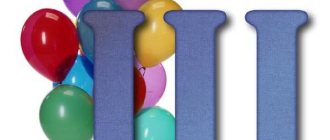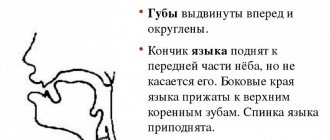What prevents you from pronouncing the letter “r” correctly?
The main reasons why this sound is not pronounced are problems associated with the oral cavity.
Short hypoglossal ligament
Another name is bridle. It is this that prevents the tongue from moving freely. Usually this defect is corrected in the maternity hospital. It can also interfere with your baby's ability to latch onto the nipple properly during breastfeeding. If this defect was discovered at school age, it is stretched with speech therapy exercises.
Problems with phonemic awareness
Phonetic hearing is the ability to hear and perceive sounds correctly. At three years old, children should be able to distinguish sounds that are similar to each other, although they cannot yet pronounce them. In some cases, such disorders are associated with adenoids and other diseases. Thus, the child does not hear a certain sound and in his speech he replaces it with another similar one.
Incorrect speech breathing
To correctly pronounce sounds, including the letter P, you need to control your exhalation. Not all children can do this at an early age. Some raise their shoulders to do this, others do not know how to regulate their breathing during speech.
Bite
A correct bite involves the upper teeth overlapping the lower ones by about a third, the remaining teeth should close tightly together. With an incorrect bite, it is physiologically impossible to produce some sounds correctly. The child's bite will need to be corrected.
Reasons for incorrect pronunciation
A set of art exercises.
Forms of rotacism:
- Distorted pronunciation.
- Lack of sound in the child's speech.
- Replacing one sound with another.
Causes:
- Disorders of articulatory motility and the structure of the articulatory apparatus: short frenulum, narrow or enlarged tongue, malocclusion, lack of teeth, high palate.
- Violation of central regulation of breathing. The rhythm and coordination of inhalation and exhalation are disturbed. Exhalation occurs through the nose during throat pronunciation. The defects are caused by changes in muscle tone, limited mobility of the muscles of the larynx, soft palate, vocal folds, tongue and lips.
- Pedagogical neglect. The child does not hear literate speech in everyday situations; there is no literacy training. Adults consciously imitate his pronunciation, changing sounds, and do not correct incorrect sounds. They do not read literary works to a preschooler, nor do they have long conversations with him.
- Phonemic hearing impairment. The child does not distinguish phonemes of his native language, mixes them up, and does not understand the speech of others well.
Speech breathing problems
Speech breathing is the basis of spoken speech. It is responsible for voice-forming and articulatory functions. Speech breathing is the ability of a person to take a short, deep breath and distribute the air when exhaling while simultaneously pronouncing various sounds. Inhalation is 5-8 times shorter than exhalation. The long-term output is where speech is formed. With correct speech breathing, the child speaks clearly and expressively, observing pauses.
Preschoolers do not control themselves, they begin to speak while inhaling or on the residual output, and take in air before pronouncing each word. This affects correct pronunciation. If the child does not pronounce “R”, correction work should begin with breathing.
Hearing impairment
Phonemic hearing is the ability to distinguish, analyze and differentiate heard phonemes. From birth, children master their native speech by imitation. By the age of 4, a preschooler has developed the technique of pronunciation of all sounds, except sonorous ones.
Impaired phonemic hearing (dyslalia) complicates the perception of oral and written speech in school education, therefore, correction of defects is necessary as soon as they are detected.
Speech therapy exercises for the development of phonemic hearing, which parents can do independently:
- The adult names a series of sounds, and the child claps his hands when he hears the one in question.
- The adult claps his hands or taps a pencil in a rhythm that the child must repeat.
- The adult dictates sound combinations, the child repeats them.
- The adult shows the pictures, the child chooses those with the hidden sound.
- The adult names the words correctly and incorrectly, the child claps his hands when he hears the correct option.
Automation of the letter "P".
Insufficient development of speech organs
Immaturity of the speech apparatus is the main cause of pronunciation problems in preschool children. The speech apparatus consists of 2 sections: central (brain sections) and peripheral (tongue, lips, soft palate, lower jaw). Brain disorders are diagnosed and corrected by a neuropsychologist. Defects in the articulatory apparatus are eliminated by a speech therapist-defectologist in a playful manner.
Individual structure of the frenulum
A shortened frenulum and anomalies in its location are a defect of the oral cavity that occurs in early childhood. The problem can be effectively solved surgically; if you contact a specialist in a timely manner, the hypoglossal ligament is stretched with the help of exercises and speech therapy tools.
How can a child distort "R"
Incorrect “r” sounds are called rhotacism - these are the sounds that are replaced instead of this letter. Before determining exercises for producing the sound R, it is necessary to understand exactly how the child pronounces this sound. It happens like this:
- Burr or speaking through the throat. When pronounced, the palate vibrates instead of the tip of the tongue. A similar phenomenon is more typical for French, but not for Russian.
- Lateral "R". This happens if the side is pressed against the upper jaw, the opposite side hangs down. In this case, the tip cannot vibrate, and the sound P itself is more similar to “rl”.
- Single-stroke "r". Instead of shaking, the tip hits the roof of your mouth. This is how the English letter “R” is pronounced.
- Pronunciation through the nose. The air flow must pass through the mouth.
- Kucherskoe R. The tongue vibrates on the pressed lips, resulting in the sound “tpr”, not a pure R.
- Pararotacism. This is the phenomenon of replacing the sound P with another, for example G.L,V.
- Pass. The child simply does not pronounce this sound at all and misses it in his speech.
Possible difficulties
If there is difficulty in performing these exercises with an open mouth or if “jumping” movements of the lower jaw are observed simultaneously with the work of the tongue, a wooden spatula or a rubber block (toothbrush) should be inserted from the side between the molars, which will act as a spacer. Soon there will be no need for mechanical fixation of the lower jaw.
Vibration of the tongue can be obtained without using a spatula if, at the moment of pronouncing “d-d-d”, you tap your palm below the chin. The child pronounces words with reverse syllables, the teacher taps his palm under the chin from below (for example, “a-d-d, i-d-d, ka-d-d, pa-d-d...”).
- When moving from the sound combinations “tr, dr” to syllables (dra-, tra-), children have difficulty pronouncing the syllables tra-, dra-. In this case, you can offer the child the following technique: clenching his fists, place them in front of his chest, and at the moment of pronouncing “dr-r-r-a”, sharply lower his hands down. You can combine saying “tra, dra” with jumping up on both legs and clapping your hands. Performing sharp and strong movements in combination with pronouncing syllables and short words switches the child from excessive concentration on articulatory movements and facilitates the transition from the isolated reproduction of sound combinations “tr, dr” to the introduction of sound into syllables and words. The same technique can be used if it is difficult to pronounce the sound [P] when combined with other consonants (“br-r, vr-r”): clench your fists tightly and, sharply lowering them down, say: brother, bravo.
- Sometimes a child can pronounce a whispered, dull, long sound [P] with clenched teeth. In this case, the child can be asked to pronounce the sounds “trr” by biting on a wooden spatula. By gradually increasing the distance between the teeth (to do this, bite down on a spatula folded in half or three), it is possible to obtain a prolonged pronunciation of the combination “tr-rr” with open teeth. After vibration has been achieved, through various exercises on the material of syllables, words and phrases, pronounced gradually at a faster pace, it is necessary to achieve automation of the learned articulation and get rid of the excessively rolling pronunciation of the sound [P].
- To obtain the sound [P], the child must be shown (in front of a mirror) the position of the tongue: the front edge of the tongue is not at the alveoli, but at the necks of the upper incisors. When, instead of a soft Pb, a hard sound [P] is obtained, it is necessary to achieve a gradual movement of the tongue forward, to the upper incisors, based on the combination of a consonant with the front vowel [I].
When automating the sounds P and Pb in words, one should take into account the child’s articulatory abilities, his age, and the ability to master the semantics and syllabic structure of the word. It is better to entrust this difficult task to a professional speech therapist.
What exercises can you do at home?
Exercises should be aimed at the reason why the child cannot pronounce this sound R.
Exercises for the hyoid ligament
This exercise improves the elasticity of the tongue muscle and develops its mobility. The exercise consists of the following:
- try to reach your nose with the tip;
- the tongue is pressed firmly to the palate and drawn towards the throat as far as possible;
- open your mouth, bend your tongue out as far as possible;
- carried out along the inside of the teeth in different directions;
- rolls up with a shovel and sticks out.
Exercises to develop mobility of the tip of the tongue
The sound P appears only when the tip vibrates. To develop this, there are special exercises:
- bite the tip;
- click the tongue pressed to the palate;
- the protruding tongue is pressed against the lip and air is exhaled, thereby creating vibration at its tip;
- pronounce the letters D, T with your mouth open.
- "D" and "T".
Statement P
Exercises aimed at correct pronunciation:
- R is pronounced in the position of the tongue in which the sounds D and T are pronounced, but with slight vibration. To do this, the tongue is pressed tightly against the palate and the air is exhaled.
- Say "DRRRRR" or "TRRRRR".
- Connecting to the sound of vowels, for example DRO, BRO, VRE.
- Pronounce words with a combination of the letters “tr” and “dr”.
- Consolidating the result with tongue twisters.
It is advisable to do all these exercises in front of a mirror and under the supervision of an adult, who should help and advise.
Speech therapist and kindergarten
If kindergarten teachers or a primary school teacher notice a child’s diction, insufficient clarity of speech, or peculiarities of sound perception, do not neglect organized additional classes within the educational institution. In a separately formed group, where all children have speech disabilities, it is much more comfortable for them to study without embarrassment and fear of making mistakes.
The speech therapy lesson is structured so that every child takes maximum participation in it. Usually, at every stage from the organizational moment to physical education, a full-time speech therapist uses special games and exercises that help children relax and learn to speak in a new way.
Improvement in diction in a healthy and normally physically developed child occurs after the first lessons. But you need to teach him not only to mechanically reproduce sounds, but also to understand the meanings of words, to sense the difference in meaning. This will speed up and enrich the learning process.
Articulation exercises
Before starting all the exercises, you need to do gymnastics, and only then proceed to the training itself.
Swing
Loose tongue with open mouth. You need to touch the upper and lower teeth. Periodically lingers on the top for 10-20 seconds.
Cuckoo
The tip sticks out and touches the upper lip, and then goes behind the upper teeth. The mouth should be wide open.
Painter
The tongue is passed over the teeth, cheeks, and palate. The tongue is like a brush and you need to paint the inside of the oral cavity with it.
horse
The tongue makes clicking sounds.
Treat
The tongue licks the lips clockwise.
Kitty
Lick an imaginary treat from a saucer. The tongue should not be curled.
Harmonic
You need to raise your tongue and secure it to the roof of your mouth. In this position, close your mouth.
Hammer
Smile widely and tap your lower teeth with the tip of your tongue.
Mimic gymnastics
Another important stage at the beginning of the lesson, thanks to which the child’s facial muscles and articulation apparatus are prepared for further work. All exercises are performed in front of a mirror.
Exercise “Hamster and fish”. The child first puffs out his cheeks strongly, showing a hamster, after which he stretches his lips forward in a tube, like a fish. The movements alternate at least 7-8 times.
"The cat drinks milk." The child uses his tongue to imitate the movements of a cat lapping milk from a saucer.
"Surprised Arkasha and angry Masha." The child first raises his eyebrows high, as if in surprise, and then frowns strongly, as if very angry.
Lip relaxation exercises:
- smile widely with a drawn-out i-i-i-i;
- rhythmic movements with tightly closed lips, now to the right, now to the left cheek;
- movements of closed lips in a circle.
“The wizard Nikolka turns a spatula into a needle” - a wide, relaxed tongue is laid out on the lower lip in the shape of a spatula, and then the whole tongue is made narrow with a sharp tip, like a needle.
How to make the sound R
It is recommended to start with setting other sounds, and only after that move on to the letter R.
Drum
Hit your upper teeth with your tongue and at the same time pronounce the letter D. The pace gradually accelerates.
Buzzer
When pronouncing Zh, we slowly pull the tongue towards the throat. The sound Zh should go into R.
Snake
We repeat the letter C and swallow our tongue, touching the tip of the palate with it.
Turkey
You need to stick out your tongue and move it back and forth, making sliding movements with its tip along the roof of your mouth.
Komarik
You need to open your mouth, raise your tongue up and rest it on the alveoli, making buzzing sounds.
Motor
A finger is placed under the tongue and active movements are made. At the same time, the KOMARIK exercise is performed.
How to consolidate the result
If the child begins to pronounce this sound, it is necessary to reinforce this. To do this, there are some exercises:
- say R loudly several times;
- consolidate through the pronunciation of words and syllables with the letter P;
- remove exercises with “D”;
- switch to reverse pronunciations, instead of RA-RO, say AR-OR;
- use tongue twisters.
These exercises will consolidate the result and bring the pronunciation of the letter P to automaticity. At the initial stages, the amount of P should be large. The child must remember and get used to the articulation of this sound. P should be firmly fixed in his speech. An adult should pronounce it together with the baby, showing the correct pronunciation. Then the child must actively use words with R in his speech.
Introduction to Speech
Eliminating incorrect pronunciation is a long process and takes time. On average, it takes up to a year to correct the defect. The help of parents also plays a big role. If they are interested, they will study daily.
Adults can also be burry. And the same methods of sound production apply to them. It will take serious motivation to cope with a speech impediment.
Sometimes parents do not understand why they should force their child to speak correctly. His future career depends on this. Many professions have standards and people with defects will not be hired.
It will take a long time to introduce sound into speech. At this stage, it is important to engage self-control. It is necessary to correct the child, force him to remember the correct pronunciation. It is useful to learn rhymes, simple sayings, tongue twisters.
Correction of any defect directly depends on the coordinated work of a specialist and parents. Only together can they cope with the problem. The faster a child learns articulatory gymnastics and begins to perform it perfectly, the sooner a sound will be given to him.
Sound production methods
Imitation
In children under six years of age, the sound P often appears as a result of their imitation. That is why adults must speak correctly, clearly, as clearly as possible. Adults must demonstrate perfect phonetic pronunciation.
Exercises from "F"
If the pronunciation of this letter is not impaired, then when pronouncing it, the tongue is moved with a finger or a stick inside the mouth. So the letter Zh smoothly turns into R. This is reinforced by frequent repetition, gradually the child pronounces the desired sound without using an auxiliary one.
If a preschooler pronounces “F” correctly, then when pronouncing it, you can move the tongue with a stick deeper into the mouth. A short “R” is formed. Strengthen it by repeating the exercises. After automating “R”, select words without using “F”.
Exercises from "C"
The child must draw out the letter, inhale and press his tongue against the alveoli. This is how R will appear. By carrying out strengthening exercises, you can achieve complete automation of R in speech.
Production from "Z"
When pronouncing “Z,” the child lightly touches the alveoli with the tip of his tongue and simultaneously blows on the tongue. This way the required “P” will be heard with vibration. This method is similar to the “C” method and is rarely used by speech therapists.
Pronunciation of R while inhaling
Speech is pronounced when inhaling, it should be short.
Mechanical method
The sound R can be produced mechanically. This will require special speech therapy tools. The child should open his mouth and raise his tongue to the palate. At this time, the speech therapist makes tapping movements with a hammer on the alveoli and vibrates the tongue with a spatula. The sound must first be fixed with the help of instruments, then the child gets used to it and can do without them.
The vibration occurs when a wad of thick paper and string is placed on the tip of the tongue. When it is removed from the surface, you need to blow strongly on the tongue. This must be used carefully without injuring the child.
Duration of correctional work
How long does it take to develop the correct pronunciation of the sound R? In modern speech therapy there are no clear time boundaries. This applies to working with any group of sounds. It all depends on the individual characteristics of the child. You can install sound already in the first lessons (if preparatory work has been done), but the automation stage can take quite a long time.
The sound R is complex in articulation, which is why it appears in speech at an older age. There is no need to rush into automation; your task is to achieve clear sound and stable vibration. The tongue should not “slip” when the child pronounces words. To make it interesting for him, use didactic games, and not just verbal and visual material.
You can look for a specific speech therapy technique, but they are all built on the principles and practical tips outlined above. The main condition for successful correctional work is diagnosis and correctional work taking into account the individual characteristics of the child.
Setting “R” according to Khvattsev
This technique was created by teacher Mikhail Efimovich Khvattsev in 1959. This method consists of several successive steps:
- Composing individual phrases containing similar words that differ by one letter - pitifully hot, thief-ox and others.
- Causing vibrations in the tongue mechanically. To do this, knock on the gums.
- Getting the sound "R" from "D".
- Bringing pronunciation to automaticity, we pronounce syllables and words with this letter.
This technique is actively used today, although it appeared during the USSR period.
Levina's method
Rosa Evgenievna Levina created her own method in 1965, which consisted of articulation exercises for setting the letter R. At the beginning of the lessons, the fricative R is achieved, which does not have a characteristic vibration.
- The second stage is training the sounds Zh, Sh. You need to move your lips apart, but without rounding them. In this case, you need to pull out the sound Zh and move the tip of your tongue to the top.
- At the first stage, the exercises are aimed at obtaining the fricative "P" without vibration after achieving correct articulation.
- To obtain P, D is used, which must be pronounced while exhaling. The mouth should be open and the tongue connected to the upper gums.
How to conduct a speech therapy warm-up
All classes with a speech therapist or at home should begin with a warm-up. It has a number of tasks:
- develops motor skills and articulation;
- improves lower diaphragmatic breathing;
- develops oral and nasal pronunciation of individual sounds;
- activates the muscles of the palate, tongue, and pharynx;
- the child's voice and ability to speak with expression are assessed;
- a sense of rhythm is developed;
- improves the musculature of the articulatory muscles.
Here you can use various tongue twisters, rhymes, and children's songs.
Correct R sound
Speech therapists recommend putting this sound last. This usually happens at 5-6 years of age. Until this age, incorrect P is considered normal. Many children begin to pronounce it on their own, without the efforts of a speech therapist or special exercises. There are cases when the help of a speech therapist may be needed earlier. This is necessary if P has already appeared, but in the wrong form. It can be replaced by L, V and others. Normally, P should be pronounced when:
- relaxed lips;
- the distance between the lower and upper jaw does not exceed 5mm;
- the tongue is raised to the gums of the upper teeth;
- the tongue should vibrate;
- the middle part of the lingual muscle is slightly arched;
- the back part is pressed against the palate;
- the sides are pressed to the top;
- the vocal cords undergo intense vibrations.
Only in this case can the pronunciation be considered normal and correct.









